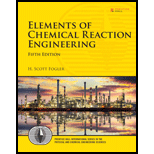
(a)
Interpretation:
Whether the catalytic reaction is limited by the external diffusion or not is to be stated.
Concept introduction:
The rate law of the chemical reaction states that the rate of reaction is the function of the concentration of the reactants and the products present in that specific reaction. The rate is actually predicted by the slowest step of the reaction.
If there is a chemical reaction which has reactants A and B that reacts to form products then their rate law is given as follows.
Here,
(b)
Interpretation:
The conditions due to which the catalytic reaction is limited by the external diffusion are to be stated.
Concept introduction:
The rate law of the chemical reaction states that the rate of reaction is the function of the concentration of the reactants and the products present in that specific reaction. The rate is actually predicted by the slowest step of the reaction.
If there is a chemical reaction which has reactants A and B that reacts to form products then their rate law is given as follows.
Here,
(c)
Interpretation:
Whether the reaction rate is limited or not is to be stated.
Concept introduction:
The rate law of the chemical reaction states that the rate of reaction is the function of the concentration of the reactants and the products present in that specific reaction. The rate is actually predicted by the slowest step of the reaction.
If there is a chemical reaction which has reactants A and B that reacts to form products then their rate law is given as follows.
Here,
(d)
Interpretation:
The conditions due to which the rate of the catalytic reaction is limited by the external diffusion are to be stated.
Concept introduction:
The rate law of the chemical reaction states that the rate of reaction is the function of the concentration of the reactants and the products present in that specific reaction. The rate is actually predicted by the slowest step of the reaction.
If there is a chemical reaction which has reactants A and B that reacts to form products then their rate law is given as follows.
Here,
(e)
Interpretation:
Whether the reaction is limited by internal diffusion is to be stated.
Concept introduction:
The rate law of the chemical reaction states that the rate of reaction is the function of the concentration of the reactants and the products present in that specific reaction. The rate is actually predicted by the slowest step of the reaction.
If there is a chemical reaction which has reactants A and B that reacts to form products then their rate law is given as follows.
Here,
(f)
Interpretation:
The conditions due to which the reaction is limited by internal diffusion are to be stated.
Concept introduction:
The rate law of the chemical reaction states that the rate of reaction is the function of the concentration of the reactants and the products present in that specific reaction. The rate is actually predicted by the slowest step of the reaction.
If there is a chemical reaction which has reactants A and B that reacts to form products then their rate law is given as follows.
Here,
(g)
Interpretation:
The overall effectiveness factor for a flow rate of
Concept introduction:
The rate law of the chemical reaction states that the rate of reaction is the function of the concentration of the reactants and the products present in that specific reaction. The rate is actually predicted by the slowest step of the reaction.
If there is a chemical reaction which has reactants A and B that reacts to form products then their rate law is given as follows.
Here,
(h)
Interpretation:
The internal effectiveness factor at
Concept introduction:
The rate law of the chemical reaction states that the rate of reaction is the function of the concentration of the reactants and the products present in that specific reaction. The rate is actually predicted by the slowest step of the reaction.
If there is a chemical reaction which has reactants A and B that reacts to form products then their rate law is given as follows.
Here,
(i)
Interpretation:
The concentration at the rate
Concept introduction:
The rate law of the chemical reaction states that the rate of reaction is the function of the concentration of the reactants and the products present in that specific reaction. The rate is actually predicted by the slowest step of the reaction.
If there is a chemical reaction which has reactants A and B that reacts to form products then their rate law is given as follows.
Here,
Want to see the full answer?
Check out a sample textbook solution
Chapter 15 Solutions
Elements of Chemical Reaction Engineering (5th Edition) (Prentice Hall International Series in the Physical and Chemical Engineering Sciences)
 Introduction to Chemical Engineering Thermodynami...Chemical EngineeringISBN:9781259696527Author:J.M. Smith Termodinamica en ingenieria quimica, Hendrick C Van Ness, Michael Abbott, Mark SwihartPublisher:McGraw-Hill Education
Introduction to Chemical Engineering Thermodynami...Chemical EngineeringISBN:9781259696527Author:J.M. Smith Termodinamica en ingenieria quimica, Hendrick C Van Ness, Michael Abbott, Mark SwihartPublisher:McGraw-Hill Education Elementary Principles of Chemical Processes, Bind...Chemical EngineeringISBN:9781118431221Author:Richard M. Felder, Ronald W. Rousseau, Lisa G. BullardPublisher:WILEY
Elementary Principles of Chemical Processes, Bind...Chemical EngineeringISBN:9781118431221Author:Richard M. Felder, Ronald W. Rousseau, Lisa G. BullardPublisher:WILEY Elements of Chemical Reaction Engineering (5th Ed...Chemical EngineeringISBN:9780133887518Author:H. Scott FoglerPublisher:Prentice Hall
Elements of Chemical Reaction Engineering (5th Ed...Chemical EngineeringISBN:9780133887518Author:H. Scott FoglerPublisher:Prentice Hall
 Industrial Plastics: Theory and ApplicationsChemical EngineeringISBN:9781285061238Author:Lokensgard, ErikPublisher:Delmar Cengage Learning
Industrial Plastics: Theory and ApplicationsChemical EngineeringISBN:9781285061238Author:Lokensgard, ErikPublisher:Delmar Cengage Learning Unit Operations of Chemical EngineeringChemical EngineeringISBN:9780072848236Author:Warren McCabe, Julian C. Smith, Peter HarriottPublisher:McGraw-Hill Companies, The
Unit Operations of Chemical EngineeringChemical EngineeringISBN:9780072848236Author:Warren McCabe, Julian C. Smith, Peter HarriottPublisher:McGraw-Hill Companies, The





